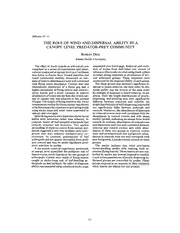
THE ROLE OF WIND AND DISPERSAL ABILITY IN A CANOPY LEVEL PREDATOR-PREY COMMUNITY PDF
Preview THE ROLE OF WIND AND DISPERSAL ABILITY IN A CANOPY LEVEL PREDATOR-PREY COMMUNITY
Selbyana 14: 12 THE ROLE OF WIND AND DISPERSAL ABILITY IN A CANOPY LEVEL PREDATOR-PREY COMMUNITY ROMAN DIAL Alaska Pacific University The effect of Anolis lizards on arthropods was suspended over forest gaps. Removal and exclu examined in a series of experiments and obser sion of anoles from individual tree crowns of vations conducted at canopy level in a Caribbean tabonuco (Dacryodes excelsa) using trunk collars rain forest in Puerto Rico. Lizard densities and revealed strong responses in abundances of sev lizard community stability (measured as vari eral arthropod groups. These responses were ance of relative abundances) were well correlated moderated by the dispersal ability of each group. with flying insect abundance. Canopy that was For those groups that showed a significant re immediately downwind of a forest gap had a sponse to lizard removal, the rank order by dis higher abundance of flying insects and insectiv persal ability was the reverse of the rank order orous lizards and a lower variance in relative by strength of response to lizard removal. In ad abundances oflizard species than did closed can dition, while the length distributions of poorly opy or canopy that was adjacent to but upwind dispersing, leaf-dwelling taxa were significantly of a gap. The supply of flying insects to the Anolis different between removals and controls, the communities within the forest canopy was shown length distributions ofw ell-dispersing insects did to be determined by exposure to prevailing winds not significantly differ between removals and using sticky-traps and wind vanes suspended in controls. Moreover, the abundances of dipterans canopy and over gaps. in removal crowns were well correlated with the Most flying insects were dipterans whose larval abundances in control crowns and with mean habits were terrestrial rather than arboreal. In weekly rainfall, indicating an escape from lizard contrast, nearly all leaf-sampled arthropods had control. In contrast, abundances of orthopterans entirely arboreal life histories. The spatial and blattarians were not well correlated between decoupling of dipteran source from canopy pre removal and control crowns, and while abun dation suggested a one-way predator-prey inter dances of these two groups in removal crowns action that may enhance predator-prey co were well correlated with new leaf growth, abun existence. In contrast, populations of leaf dances in controls were not well correlated with arthropods did not appear decoupled from pred new leaf growth. Lizards exerted control on these ator control and may be under significant pred groups. atory selection by anoles. The results indicate that wind provisions A six-month removal experiment performed crown-dwelling anoles with limiting food re at canopy level quantified the predatory role of sources (flying insects). These insects are not con insectivorous Anolis lizards on the two groups of trolled by anoles, but instead respond to rainfall. arthropods. Counts were made of flying insects Local crown populations of poorly dispersing ar caught in sticky-traps and of leaf-dwelling ar thropod groups are controlled by anoles. These thropods on leaf surfaces. An index of dispersal groups respond to an increase in their resources ability was measured using cylindrical sticky-traps when lizards are absent but not present. 12
